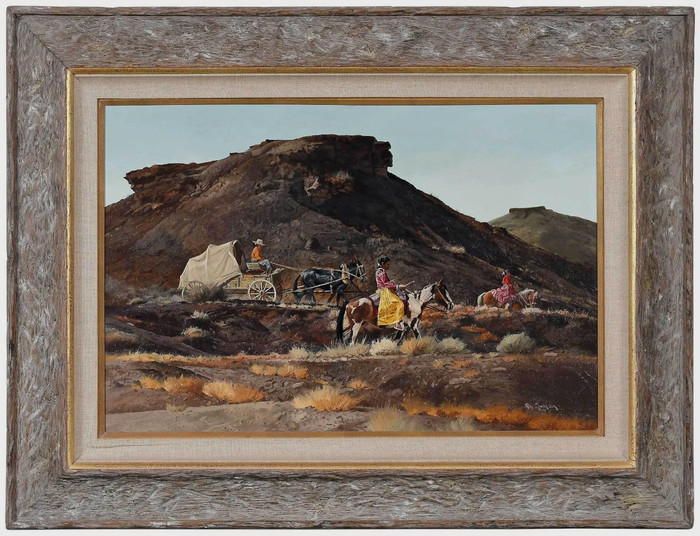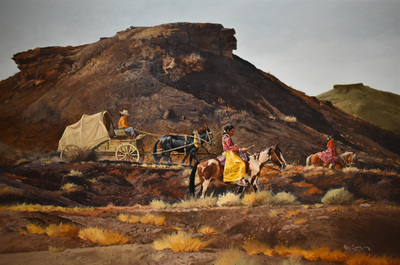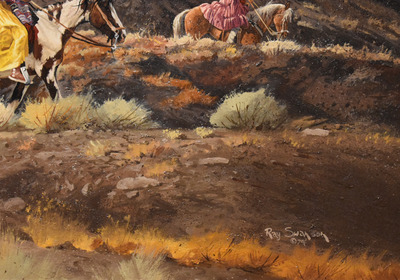Ray Swanson "Going Home"
-
- Ray Swanson
- (1937-2004)
- Arizona Artist
- Image Size: 20 x 30
- Frame Size: 32 x 41
- Medium: Oil
- Dated 1974
- "Going Home"
- Contact for Price & Info
- View All By This Artist
Details
Western, Cowboys, Indians, Native American Horses Covered Wagon
-
Biography
Ray Swanson (1937-2004)
A member of the Cowboy Artists of America and the American Watercolor Society, Ray Swanson was known for his Southwest Native American subject--the Navajo, Hopi, Zuni and Apache Indians. He was especially known for depicting children and smaller animals belonging to these tribes and for the beauty of their traditional costumes.
Swanson was raised in rural South Dakota and settled in Carefree, Arizona. He first visited a Navajo Reservation in Arizona in the early 1960s, and from that time, incorporated Indian figures and genre into his subject matter.
He attended a one-room schoolhouse in South Dakota and was early recognized for his art talent. His father was killed when Ray was young, and the family moved to California where he enrolled at the Northrop Institute of Technology in Los Angeles. He worked full time as a draftsman and studied aero-nautical engineering. For six years, he was a civil engineer in Redlands, California, and during that time married Beverly, his high school sweetheart.
He also began to paint, encouraged by his wife and friends, and he displayed his work at the curio shop he and Beverly opened in Oak Glen near Los Angeles. Gallery owners in New Mexico and California began carrying his work, and he became a full-time painter.
In 1973, he and Beverly sold the shop and moved to Arizona where he continued to paint the Native Americans. He also painted some landscapes and seascapes in both watercolor and oil and traveled widely in search of subject matter beyond Arizona.
In 1979, he was named Arizona Artist of the Year and in 1986 was voted into membership of the Cowboy Artists of America, which he served as president at the time of his death in 2004. He was also a signature member of the American Watercolor Society.
Following are excerpts from the obituary of the artist by Dolores Tropiano, The Arizona Republic, December 24, 2004.
"Ray Swanson, president of the Cowboy Artists of America and one of the most poignant painters of Arizona Indians, was remembered this week by artists, fans and the people whose images covered his canvasses.
The Carefree resident died Dec. 17 of pneumonia after contracting multiple myeloma, a cancer of the blood plasma cells. He was 67.
'Ray touched many lives, including people who couldn't afford his original paintings, but who would stand in line for an hour to get his autograph at the cowboy (artists) show,' said Steve Todd, a Tempe art collector.
In October, Swanson's painting Women of the "Dineh formed a huge banner that hung outside the Phoenix Art Museum, promoting the Cowboy Artists of America's 39th-annual exhibition.
But Swanson never saw the banner or the show. By then, he already was very sick.
"It was one of the last paintings he ever created, and it hung outside the museum. He never got to see it, but it was a fitting tribute," said Todd, chairman of this year's CAA exhibition.
"He painted and produced a magnificent show, and every piece sold. It was a fantastic show," Todd said.
Swanson was recognized and renowned for depictions of various cultures. But it was the Hopi, Zuni and Navajo in particular that he captured in a special way.
Members of a Navajo family that Swanson painted attended Wednesday's memorial service at Desert Springs Bible Church in northeast Phoenix. They followed the casket into the church, covering it with a traditional chief's blanket.
"He respected his subjects, the Navajo people, and they trusted him," Todd said. "He painted them honestly and proudly."
According to Joan Griffith, director of Trailside Galleries in downtown Scottsdale, Swanson's knowledge of the Navajo people shined through his oils and watercolors.
Swanson's paintings were filled with "dramatic light and jewel-like colors," Griffith said, adding that they conveyed "a deep, spiritual interpretation of ordinary lives."
Like others, she was surprised by Swanson's sudden illness and death.
Jim Ballinger, director of the Phoenix Art Museum, said of Swanson, "He was still in his prime. He was a really wonderful gentle man. It (his death) is just a huge loss to so many people that depended on him. He was a delight."
Swanson was born in Alcester, S.D., and grew up on a farm. Swanson started painting as a young man after he was given his grandfather's oils and other art supplies.In the boulder-strewn hills of Carefree, just north of Scottsdale, stands an elegant Santa Fe style home and studio. It is here amid the tall Saguaro and rough rocks that Ray Swanson's love of the Native Americans and their fading lifestyles is put to canvas under the watchful eye of the Sonoran Desert which seems to merge with his studio through panoramic windows facing the venerable Black Mountain.
A South Dakota native who was raised in a rural environment, Ray has come to identify with the gentle people who inhabit the bold and visually stark lands of the Colorado Plateau. His connection to these people is an outgrowth of his own rural roots where simplicity allowed one to feel a sense of communion with nature. It was on one of Ray's first trips to Arizona that he knew he had to chronicle the lives of the Native Americans as he could see that their lifestyles were under attack from outside forces.
Over the years as he has painted among the Navajo and Pueblo peoples, Ray has witnessed drastic changes in their patterns of dress, use of modern forms of transportation and construction of non-traditional housing. He finds a great sense of satisfaction in being able to bring to life in either oil or watercolor the time-honored lifestyles that are quickly fading from everyday view.
Collectors from all over the world seek out the art of Ray Swanson. He depicts both the native peoples and their way of life with tenderness and dignity. His style is considered as representational, with every detail clearly visible. His success won him election to the prestigious Cowboy Artists of America in 1986. His resume includes numerous awards and a recent book, "The Art of Ray Swanson - Celebrating People and Lifestyles". Over the years, Ray has chronicled traditional ways of life in both Europe and Asia, but he is still most noted for his spiritual and emotional depictions of the Native Americans of the Southwest.
Biography from Altermann Galleries & Auctioneers VIWholly self-taught realist painter of Navajo and Hopi Indians, Ray Swanson was born in Alcester, South Dakota in 1937, from 1972, lived in Arizona, first in Prescott and then Carefree. He said: "The most exciting paintings I do are portraits of the older Navajo folk. The lines in their faces show the peace within. The real challenge for me is capturing the emotions reflected in their faces."
Born on a farm, Swanson studied for eight years in a one-room schoolhouse. When his father was killed in an accident, the family sold out and moved to California. While he was studying aeronautical engineering at Northrop Institute, his grandfather who had painted as a hobby left Swanson his paint box. Swanson "figured if they were oil paints, they probably should go on oil cloth," but he persevered. After he graduated in 1960 and worked as a civil engineer, he painted farm subjects in the evenings and on weekends. With his brother Gary, he opened a diorama and gift shop where he also hung his painting priced from $25 to $75.
Swanson bought Indian merchandise for resale in the shop, became involved in studying the Indian civilization, and moved to Prescott because of the established art colony and because it was only a two hour drive from the reservations. He had become a full-time artist, "permanently under the spell of the Southwestern landscape and the effect of light on it." In 1978, Artists of the Rockies did a feature article on Swanson, and both Art West and Southwest Art followed in 1981.
Resource: Contemporary Western Artists, by Peggy and Harold Samuels 1982, Judd's Inc., Washington, D.C.



